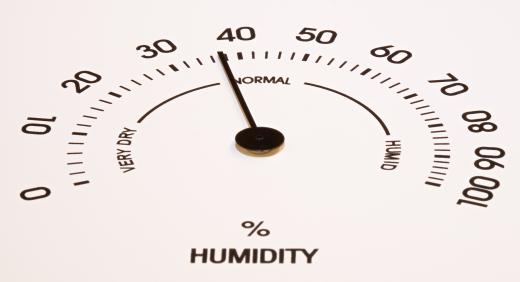What is Relative Humidity?
 Tricia Christensen
Tricia Christensen
Many people notice that hot muggy days seem much warmer somehow than days with dry heat. One of the reasons for this is humidity, the amount of water the air holds. When the air holds more water, the basic act of perspiration or sweating is less efficient in cooling down the body. More water in the air means less water can evaporate from the skin, and most people will end up feeling warmer. Some of the ways that humidity is measured is by measuring absolute humidity, and relative humidity, which is often how people tell how “wet” a day will be.
First, it’s important to understand that air can only hold a certain amount of water at any given time. This measurement is absolute humidity, and absolute humidity is dependent on the temperature of air. Under many circumstances, the actual air holds far less water than it technically could, so the term relative comes into play. When meteorologists discuss relative humidity they usually do so in percentage amounts, and this percentage is a ratio of how much water the air does hold in comparison to how much water it could hold. The actual formula is water amount (actual vapor density) divided by total possible water amount (saturation vapor density) times 100%. Most people will see the expression of this formula often in relative humidity counts when they watch or read weather reports.

That percentage or the relative humidity of a day can tell people how warm they may feel under given circumstances. Air that is drier may not feel as hot in warmer temperatures. Air at about 45% relative humidity is going to feel most like the temperature that is outside. Anything above this level may make the day feel warmer than it truly is at certain temperatures.

Temperature perception may be affected by relative humidity in the reverse. On cold days, usually those below 53 degrees F (11.67 degrees C), higher humidity can actually make people feel colder than they normally would. Though other determinants like wind chill may affect “temperature feel” and perception, relative humidity in cold weather may also be an important factor. Freezing weather with a near 100% relative humidity may be much chillier in feel than freezing weather with a lower level of humidity.

The relative measurement of humidity cannot be the only determination of how weather will feel; the amount of wind, especially in colder temperatures and other factors come into play. Moreover, individuals can be more or less sensitive to certain temperatures. However, it is one good way of determining just how hot or cold a day might feel.
AS FEATURED ON:
AS FEATURED ON:














Discussion Comments
@Grivusangel -- That meteorologist was probably one who looks more at dewpoints. That's the "second" temperature you see that indicates how saturated the air is for the temperature. The closer the dewpoint is to the actual air temperature the more humid it is -- and often, the more unstable the air is. Dewpoint is a big factor in determining the possibility of severe weather in a given area.
By the same token, during the winter, the dewpoint is often a good predictor of how low the temperature will drop overnight. The lower the dewpoint, the lower the temperature will likely go, since dry air doesn't hold heat nearly as well.
Still, relative humidity is, as you say, a good indicator for the average person of how muggy the day may be.
One local meteorologist says relative humidity is "relatively useless." I guess that's from a scientific point of view. From a layman's way of looking at it, relative humidity is at least a point of reference for how miserable the heat will make you on a given day.
It's pretty much a given that a humidity reading below 50 percent is going to mean the air is drier and more comfortable, even if the air itself is warm.
I've been in 95-degree temperatures that felt fairly comfortable because the humidity was low. But I've been outside when the temperature was 80 degrees, but humidity was really high and it was miserable.
Post your comments